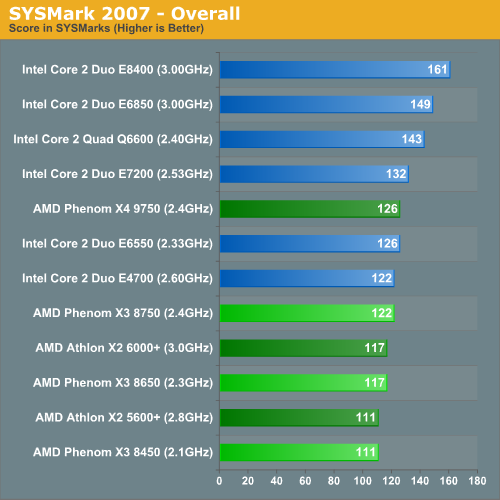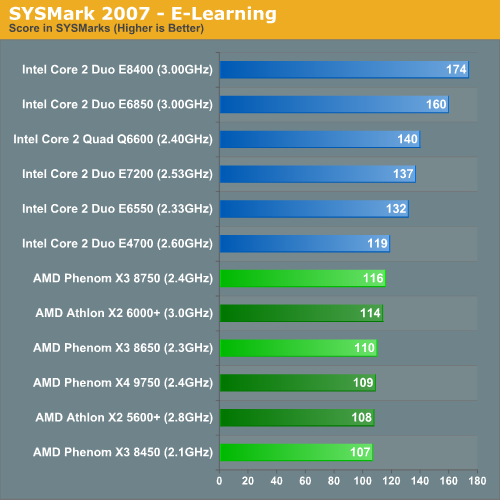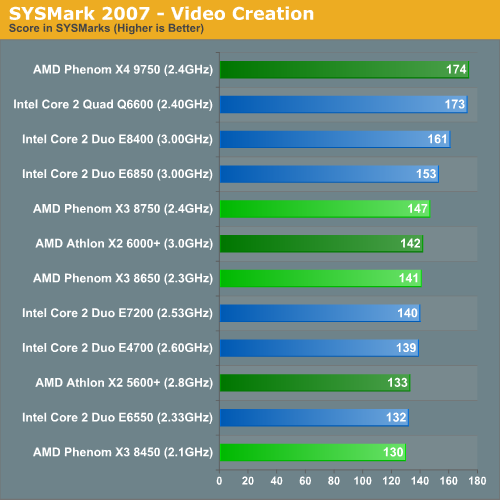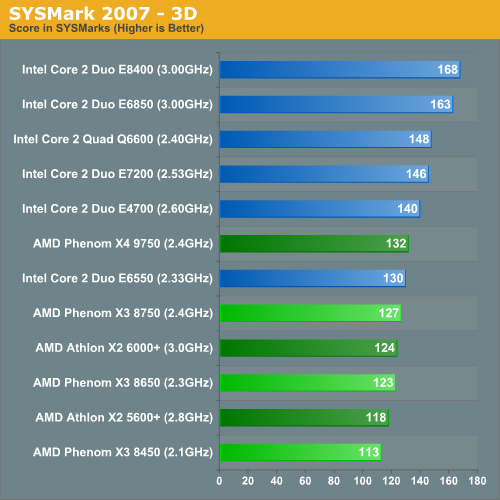AMD's Phenom X3 8000 Series: Fighting Two Cores with Three?
by Anand Lal Shimpi on April 23, 2008 9:00 AM EST- Posted in
- CPUs
Overall System Performance - SYSMark 2007
SYSMark 2007 is an application benchmark suite that plays back real world usage scenarios in four categories (E-Learning, Video Creation, Productivity and 3D), using the following applications:
Adobe After Effects 7
Adobe Illustrator CS2
Adobe Photoshop CS2
AutoDesk 3ds Max 8
Macromedia Flash 8
Microsoft Excel 2003
Microsoft Outlook 2003
Microsoft PowerPoint 2003
Microsoft Word 2003
Microsoft Project 2003
Microsoft Windows Media Encoder 9 series
Sony Vegas 7
SketchUp 5
WinZip 10.0
Performance is measured in each individual category and then an overall score is reported.

AMD's Phenom continues to suffer under SYSMark, looking at overall system performance - Intel's Core 2 lineup is just stronger. The fastest triple-core CPU is on par with Intel's $133 dual-core E4700. It's also worth mentioning that the triple-core Phenom CPUs are barely any faster than the higher clocked, dual-core Athlon X2s.
Also pay close attention to the Core 2 Duo E7200, this little beauty manages to offer better performance than the E6550 despite having a slightly smaller L2 cache and slower FSB (3MB vs. 4MB and 1066MHz vs. 1333MHz).

The E-Learning suite mostly echoes what we saw in the overall SYSMark results.

The Video Creation tests have the triple-core Phenom X3 far more competitive, the fastest entry in the chart is actually the Phenom X4 9750.

The last two test suites show results in-line with what we've already seen under SYSMark: AMD's Phenom wasnt particularly speedy with four cores, and disabling one of them doesn't help any.











45 Comments
View All Comments
Locutus465 - Wednesday, April 23, 2008 - link
I just upgraded my system to the following last night (running vista ultimate ed. 64bit).AMD Phenom 9850be (at stock speed for now, with packaged heatsink).
4GB OCz DDR2 800 memory (at stock speed)
ASUS M3A32-MVP Deluxe / WiFi-AP AMD 790FX
DIAMOND Viper Radeon HD 3870
Soundblaster x-fi Fatal1ty
The rest of my system stayed the same, primary hdd = WD Caviar SATA 7200RPM, secondary = Segate SATA 7200RPM, page file running off of secondary disc rather than system disc etc.
I can tell you right now that the all AMD platform is very strong. As my primary display I have a 19" LCD running 1280x1024 and I run all games with all graphics options set to max and never get below 70FPS on any game I know how to pull the FPS for. I'm able to run crysis very smoothly at the same resolution with medium graphics settings, I have not yet tried cranking things up though. Additionally I've had to take some of my work home which delt with converting a 3GB pipe delimited file in to several smaller files then converting those into valid CSV files (using excel), on my new system this process was very quick. For your reference below is a list of every game I've tried on my system, they ALL play silky smooth.
Doom 3
Quake 4
Age of Empires III
F.E.A.R
Oblivion
Half Life 2
Half Life 2 EP1
WoW
*Crysis
*only game I don't have graphics/audio settings fully maxed on.
Since upgrading I've also taken to gaming on my 720P Toshi DLP using the DVI to HDMI converter packaged with my video card and audio running through my AVR via multi-channel analog inputs. All I have to say is damn is that fun!!!
Ensoph42 - Wednesday, April 23, 2008 - link
I don't understand why every review I've seen for the Phenoms use DDR2-800. I thought one of the perks was that you were supposed to use DDR2-1066 to get max performance. Someone explain this to me.niva - Wednesday, April 23, 2008 - link
I have a phenom 9600 with 8Gb of RAM, I had major issues getting the RAM to 1066 and remaining stable, simply stayed with 800 for stability reasons. Then again, I don't play games much so I'm not concerned about squeezing out an extra 1-5% performance for the sake of stability.Of course I didn't play with this too much, maybe I was doing something wrong but I've not found a good guide saying exactly what I need to set for the system to remain stable.
Ensoph42 - Wednesday, April 23, 2008 - link
I hear you. Although is it that your mem is rated at 800 and wont OC to 1066? Or rated for 1066 but just isn't stable period at that speed?However the GIGABYTE GA-MA78GM-S2H, that is used in the review, has a memory standard of DDR2-1066. One of the selling points of the Phenom, I believed, was the memory controller supported DDR2-1066.
I found this link here that takes a look at performance differences. I havent given it a close read since it's late, and seems limited but:
http://www.digit-life.com/articles3/mainboard/ddr2...">http://www.digit-life.com/articles3/mainboard/ddr2...
perzy - Wednesday, April 23, 2008 - link
Well unless the software is as well written as Unreal engine 3 (Tim Sweeney is a god),in 95% of the programs avrege Joe use (including windows itself) there is very little advantage even going from singlecore to dualcore!Which brings me to my question: Whats really going on with the 'Heat wall' 'Frequenzy wall' or whatever you call it that Intel hit so hard in 2004(-ish) ? (remember the throttling superhot 3.8 GHz P4's ?)
What all users really need is higher frequenzy! Why arn't we getting it?
Clauzii - Wednesday, April 23, 2008 - link
The frequency wall can be considered like cooking the electrons off of the DIE-surface, which is not so good. High frequency=High heat. Now Youre thinking, "But IBM got 6GHz?". It's a different design philosophy: Simpler pipeline, faster frequency.Until ALL programs/OSes support multi-threaded programs, we are bound to single-threaded OR the pseudo Hyperthreading which can do SOME multithreading, depending on the Code & Data used.
If I've used a 8 GHz machine to write this on, I would still only be able to see the cursor rate one pr. sec.
What I think we need are (even more!) intelligent CPUs (GPUs). If a CPU or GPU knew approx. what kind of performance and usage of power a program needs, a more sofisticated power scheme could be possible??
Until then, All I know is that evolution goes forward. Not always fast, but forward :)
Nehemoth - Wednesday, April 23, 2008 - link
...(or give up 200MHz and get a quad-core X3 9550 at the same price)...Should be Quad-Core X4 no X3
MrBlastman - Wednesday, April 23, 2008 - link
I'd like to see them include the X2 6400 in the benchmarks as well. I see that they might be trying to get the pricing in line, but for an AMD user looking to upgrade, all I really am considering right now is a 6400, X3 or X4, nothing else.The UT 3 benchmarks shed some hope for the Phenoms as they show with a properly coded game, the X4's can remain competitive. I still wish to this day they'd release 3+ GHz phenoms :(
ImmortalZ - Wednesday, April 23, 2008 - link
Any MPEG4 AVC video encoded at Profile 4.1 or lower is fully accelerated by today's GPUs. Scene releases from the past few months confirm to this - and even with this, most of the older release are still compatible given you use the proper filters.ImmortalZ - Wednesday, April 23, 2008 - link
* By Profile I meant Level.